RIGHT TURN ONLY!!
Ultimo Fighting Championship
by Carlo Santos,

YES! It's discounted candy time at the supermarket again!
... Except that, this time of year, all of it is packaged in pink.
But I don't care! 50% off is worth it to drown my sorrows in chocolate!
20TH CENTURY BOYS
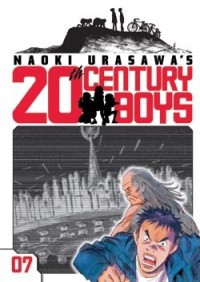
Vol. 7
(by Naoki Urasawa, Viz Media, $12.99)
FROM THE BACK COVER:
"Out in the middle of Tokyo Bay, a man called Shogun is trying to break out of Umihotaru Prison, a maximum-security island fortress, so he can save the world. Accompanied by a frightened young manga artist, these two men are prepared to risk everything as their daring escape plan grows deadlier by the minute. However, the prison authorities will do whatever it takes to return Shogun and his reluctant companions to custody.
Shogun's ultimate goal: Tokyo, where a girl he calls the 'final hope' lives, but a murder in Kabuki-cho has triggered a chain reaction of terror. Can Shogun reveal the truth about the false peace created by the Friends? And what are the facts behind the disaster that took place in the final moments of the 20th century?!"
EVIDENCE FOR:
It's 2014, where are my flying cars? Well, technological marvels probably aren't that big of a deal when the real marvel is watching Naoki Urasawa take the classic "oppressive post-apocaplyptic future" scenario and spin it in his own style. The jailbreak that began in the previous volume continues to impress with edge-of-your-seat suspense, as our two unlikely heroes fend off every possible danger by sheer force of will. But all that future stuff was just preparation for what this volume plunges into next—a dramatic detailing of the "Bloody New Year's Eve" incident that is the whole centerpiece of the series. By approaching the event from both sides of the timeline—anticipating it with the characters' childhood years (and still flashing back there occasionally), then looking back on it from a dystopian future—the pivotal moment is thrown into much sharper relief. Had Urasawa given it away too soon, it would never have achieved the excitement and drama that it does now. A variety of locales helps to keep things visually interesting: open waters, downtown Tokyo, a building rooftop ... all rendered in the clean, polished art style that makes this series pure addiction to read.
EVIDENCE AGAINST:
It took long enough to get to the actual Bloody New Year's Eve event. Now how long is it going to take to explain what happened? After jumping out of the surprisingly enjoyable future arc and getting back to the "present day," 20th Century Boys seems to have returned to its bad old ways, playing for time and keeping things in suspense longer than it needs to. This volume only covers one dramatic confrontation so far, with everything being ragtag heroes running around trying to gather information and reminiscing on their childhood days. Who's got time for wistful recollections about hijacking the school's P.A. system when you're trying to save the world? As a result, the pace is already dragging by the time it hits the final chapter, even though the End Of The World has only lasted about half a volume so far. Instead of a cliffhanger ending with a bang, we get a stillborn pause—and really, the apocalypse ought to be more exciting than that.
FINAL VERDICT:
Escaping from a maximum-security prison? Awesome. Saving the world using your childhood memories and 20th-century pop culture? Also awesome. This volume in general? Awesome with a capital A-.
PANIC X PANIC
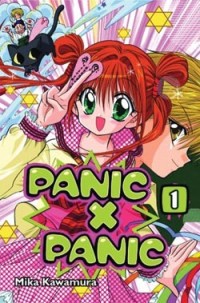
Vol. 1
(by Mika Kawamura, Del Rey, $10.99)
FROM THE BACK COVER:
"Mitsuki and Kakeru are childhood friends—and rivals! When Mitsuki is attacked by a demon, she and Kakeru discover that they have magical powers. An ancient scroll decrees that they must work together to save the world from a demon invasion. And so begins a demon-filled adventure..."
EVIDENCE FOR:
Miracle of miracles! A Nakayoshi manga-ka who actually knows what she's doing with her pen? Yes, Mika Kawamura's confident and distinctive style instantly gives her an edge over all the cookie-cutter artists who think that 0.005 mm nibs and armor-piercing chins are the way to go. With bold lines and supercute character designs, Panic x Panic catches the eye instantly, and then keeps it there—thanks to page layouts that flow in a definite direction, rather than the "here's a montage of pictures and guess which panel you're supposed to read next" format. The story, too, avoids the much-overused mold where every middle-school girl in the country wants to meet cute boys and be a famous pop star/pastry chef/fashion designer. Instead we've got supernatural demon-hunting action (the fun part is trying to guess which creature from Japanese folklore pops up next), mysterious fortunes, and plenty of acerbic back-and-forth dialogue between the two main characters. Add in the back story about Mitsuki being a shrine heiress and Kakeru being ... well, some kind of Christian, and now you've got a shoujo story that actually has some substance to it.
EVIDENCE AGAINST:
Failure of failures! In lieu of the usual "middle school girl wants to meet cute boys and be a pop star," we get a middle school girl who fights the monster of the week, which can hardly be called an improvement. And she has to team up with a cute boy to do it. Of course. The repetitive, formulaic plot is also not helped by the predictable nature of the villains; the way these creatures show up in the story, they might as well be wearing signs saying "You will have to fight me in the climactic scene of this chapter" around their necks. Not that the fighting is all that great anyway—Kawamura may have a cute and appealing style, but it doesn't lend itself to the supernatural action genre at all. The monsters are too cuddly to be fearsome, and the magic is too weak to be impressive, resulting in a sanitized Hello Kitty Demon Hunting experience. Plus when the supplementary character profiles offer more depth than the actual characters themselves, is it even possible to feel invested in the story? ... Didn't think so.
FINAL VERDICT:
It's enjoyable enough and somewhat different from the norm, but major clichés and flaws mean that this gets stuck with a C+.
PLUTO
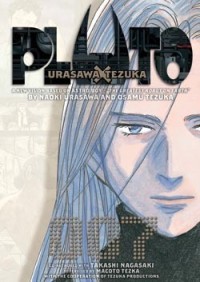
Vol. 7
(by Naoki Urasawa and Osamu Tezuka, Viz Media, $12.99)
FROM THE BACK COVER:
"Pluto has destroyed six out of the seven great robots of the world, and the pacifist robot Epsilon is the only one that remains. Will Epsilon, who refused to participate in the 39th Central Asian War, leave behind his war-orphaned charges to step onto the battlefield? It just might be that kindly Epsilon, who wields the limitless power of photon energy, will be Pluto's greatest opponent of all!"
EVIDENCE FOR:
In this volume, there is a big fight. But it is Pluto's quiet in-between moments, the expectant pauses, the wistful memories, that deliver the biggest impact. Even in the heat of battle, loaded with special effects and intense imagery, it is the cry for help from within Pluto's soul that resonates more strongly than any attack. There are also the occasional interludes with Epsilon and his kids, which Urasawa always illustrates with a warm, slow-paced poignancy. But for the moment that really brings out every emotion at once—the hope, the dread, the sorrow, the joy—it's the remarkable "awakening" in the last chapter that will surely move the heart of anyone with a pulse. The final act has arrived at last, and a good thing too, since the storyline has gotten a lot more enjoyable now that we're down to one last robot and the loose ends have been connected to each other. Speaking of loose ends, if you were still wondering what Pluto looked like ... finally you get to see. Once again, Urasawa does a fine job of integrating Tezuka's design with his own polished style, and his unique, dramatic vision of the future is as slick as ever.
EVIDENCE AGAINST:
Doesn't this guy know how to differentiate flashback scenes from present-day scenes? Seriously, if Urasawa's storytelling style is confusing in this volume, it's not because he's withholding information—we pretty much know what needs to be known—but because he jumps from scene to scene without warning. Hey, here's a shocking experiment Professor Tenma conducted years ago, except it looks like it was just a continuation of the previous scene! Here's another flashback of what Gesicht saw before he died, that doesn't have any connection to anything! And that's the trouble with genius-level artists sometimes—they see the big picture, they know how everything fits together, but they forget that this understanding may not come so easily to normal people. Maybe that's also why Urasawa continues to add pointless little flourishes to the story: references to Pinocchio, a creepy little children's song, a symbolic crack in a wall ... it probably all has some kind of thematic unity in his head, but it sure doesn't do much to advance the story.
FINAL VERDICT:
Some flaws here and there, but it's nice to see everything coming together at last. A strong, dramatic storyline and polished visuals add up to a B+.
SAYONARA, ZETSUBOU-SENSEI
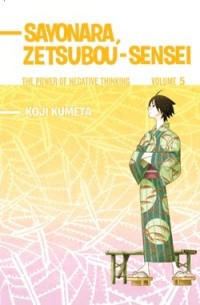
Vol. 5
(by Koji Kumeta, Del Rey, $10.99)
FROM THE BACK COVER:
"Zetsubou-sensei has won a trip to a hot spring, but when he finds several of his students there in the bubbling pools, he launches into a tirade about the evils of detoxing. To Zetsubou-sensei, detoxing is a metaphor for sanitizing the world of the very complexities and idiosyncrasies that define it. So put down that bar of soap and pick up Volume 5 of Sayonara, Zetsubou-sensei."
EVIDENCE FOR:
Could it be? Has the art in Sayonara, Zetsubou-sensei actually improved? Somehow a light bulb has gone off in Koji Kumeta's head, and suddenly he's doing a much better job of spacing out the high-contrast style, arranging the panels to match the rhythm of the jokes, and basically taking control of the tight 14-page limit (rather than letting it control him). Now that the series has found its visual groove, all that remains is for the humor to fall into place—which it does easily. As always, the suicidal schoolteacher's observations are at their wittiest when pointing out the everyday foibles of humankind: witness the oh-so-true "white lies" chapter, or the one about secret codes (a.k.a. How To Translate Bureaucratese), or even the strange logic of the "too much evidence" effect (if something appears too stereotypical and obvious, then you start believing the opposite to be true). Meanwhile, the more absurd gags reveal Kumeta's imaginative streak, like when all the kids in Zetsubou-sensei's class get detoxed and end up transformed into Stepford students; an even more dramatic role reversal awaits in the "dream ending" chapter. Whether mundane or fantastical, there's a laugh on practically every page of this volume.
EVIDENCE AGAINST:
Wait ... did we just go through an entire run of Zetsubou-sensei without him actually crying out, "I'm in despair"? Sadly, it seems that one of the greatest catchphrases of the past decade (others include: "I'm only interested in aliens, time travelers and ESPers"; "Believe in me who believes in you") has been gradually phased out of the very series that originated it, perhaps out of the creator's own fears that it was getting old. Which is understandable, but still kind of a shame. And as always, we get a couple of off-chapters where the joke loses its edge amid all the ranting and raving. What exactly does self-completion" mean, and how does it relate to the examples given? And what's this deal with two feuding parties that reconcile awkwardly? It's not the cultural references that are the problem—although, yes, your comedy mileage will vary depending on your knowledge of Japanese entertainment and current events (in 2006)—but rather, the problem is that some of the ideas just don't follow through.
FINAL VERDICT:
Despite a couple of missteps, this is—once again—the very definition of piercing, culturally aware satire. Plus the artwork has gotten better! A- material right there.
ULTIMO
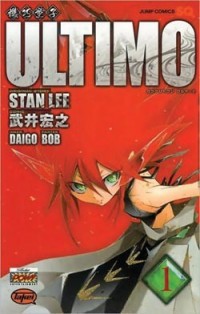
Vol. 1
(by Hiroyuki Takei, concept by Stan Lee, Viz Media, $9.99)
FROM THE BACK COVER:
"Ultimo and Vice are Karakuri Dôji, the mechanical embodiment of pure good and pure evil, devoid of human emotions that can cloud one's judgment. Their purpose: to battle to the death to prove once and for all whether good or evil is the most powerful force in the universe.
With girl and money troubles, life is hard enough for high school student Yamato, but then he stumbles upon Ultimo, a peculiar looking puppet. Things only get stranger when Ultimo awakens and his archenemy Vice shows up. Will this be the battle that finally decides good and evil, or is this just the beginning of a most fantastic adventure?"
EVIDENCE FOR:
It may be a self-promotional marketing ploy to keep Stan Lee's name in the media, but that doesn't stop Ultimo from being pretty interesting. The use of puppets as protagonists cleverly dodges the overused "high school boy discovers amazing powers" cliché—Ultimo can fly around and throw energy blasts, but it's his master Yamato who provides the true power source. The overriding concept, too, breaks out of the typical shônen mold (keep fighting random guys until you get to the toughest guy!) and offers an existential query in the guise of a hot-blooded action comic. What if you could create a humanoid representation of good and evil? How would they interact? And what if there were other puppets that embodied other human qualities? That last one is hinted at in the later scenes, when we find out that mysterious old man Dunstan (Lee's amusing little cameo role) has created other puppets besides the first two, and that there may eventually be an all-out war. If it comes to that, Takei's sinuous artwork should do just fine, with stylish spikes and curves giving each battle a unique visual flow.
EVIDENCE AGAINST:
Well, that's nice that Takei can do spikes and curves and make the battles look cool. Because when it comes to other artistic aspects like character design, his style is kind of a joke: high school kids with freakishly oversized foreheads (except for Yamato, of course), older men reduced to goofy caricatures, and—in the introductory chapter set in the 12th century—lots of generic-looking feudal warriors. Good thing he's got those fight scenes to fall back on, right? Well, not if they're barely readable: at some point Ultimo and Vice's epic transformations and elaborate weaponry get too fancy for their own good, turning into a giant mess of lines. But hey, it's GOOD AND EVIL! FIGHTING EACH OTHER! Which, come to think of it, sounds cheesy as hell, and even dressing it up in mystical puppetry and centuries of back-story can't hide the hokeyness of the concept. Many of manga's great stories come from the idea of morality being a gray area, so when a legend of American comics insists on shoehorning his heroes-versus-villains worldview into the medium, it does feel out of place. Refreshing, but out of place.
FINAL VERDICT:
On one hand, it's a typical boys' action comic through and through, but the concept has potential. Chalk up a C+ for this one and see what happens next.

REMEMBER
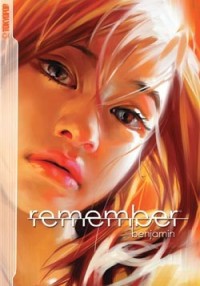
(by Benjamin, Tokyopop, $14.99)
FROM THE BACK COVER:
"What is the line that separates love from hate? How can a broken heart heal from a loss so deep? When is letting go of your inhibitions worth risking your life?
International artist Benjamin depicts profoundly moving portrayals of love and loss that get to the core of what it means to throw your heart into life. The artist doesn't offer any comfort from the despair we all feel in our lives—while we know there is no answer, we are all better off for asking the question...and remembering the struggle."
EVIDENCE FOR:
What is so refreshing about an individualistic work like Remember is that it refuses to follow any sort of formula. There is no marketing directive stating that the protagonist must appeal to 8-to-12-year-old boys; no editor breathing down Benjamin's neck telling him to come up with a serializable 20-page-per-chapter adventure. What we get, instead, is pure self-expression—emotional ups and downs experienced by youths who fall in love, and out of love, and rebel against the world, and then decide it's probably safer to conform, and everything in between. Often their feelings are so complex that the characters' words and actions seemingly come out of nowhere—but that's where readers will have to use their brains for once and figure out what everyone's thinking. There are no clear answers, and that's the point. Aside from the thought-provoking story, the stunning full-color artwork is also a breath of fresh air; this guy obviously grew up with a tablet in his hands and a computer screen in front of his eyes and knows how to make the medium work. The expressive character designs, the subtleties of color, and oh, that amazing final scene in the first story—now this is what originality looks like.
EVIDENCE AGAINST:
Yes, struggling indie comics artists are completely original ... just like everyone else. And that's the problem with Benjamin's work from the get-go: his subject matter and personal ideals are basically identical to the visionaries and creators who paved the way for him. Nobody understands my genius, to hell with money-grubbing commercial publishers, comics are a beautiful form of expression, living your dreams takes sacrifice and hard work, and art school kids are crazy. All the same old Bohemian drivel, delivered in an angsty woe-is-me monotone (at least when Felipe Smith does it, he makes it funny). The freeform story structure also backfires sometimes, like when scene transitions happen way too quickly (you can always tell when the artist wants to just skip right to a "good part" that he's got planned), and characters change emotional states for no apparent reason. Had it been a serialized work, with editorial guidance, there'd have been more room for character development. As it is, it's just a lot of roiling emotion slapped onto paper with shiny fancy Photoshop technique.
FINAL VERDICT:
Although a bit self-indulgent and rough around the edges, this daring piece of art is definitely something to turn to when you're sick of all the cookie-cutter material out there.

And here it is folks, another personal favorite of Ben Jonas that has been sadly relegated to licensing limbo! Who will be courageous enough to rescue this overlooked comedy series from the depths of obscurity? And do YOU have a personal favorite that's stuck in this same predicament? Or any series that's overlooked in general, that the world ought to know about? Tell us all about it in Reader's Choice!
NININ GA SHINOBUDEN
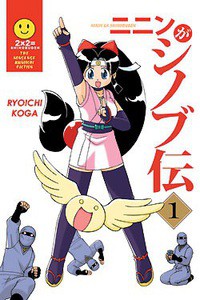
(by Ryoichi Koga, Infinity Studios, $9.99 ea. / Media Works, ¥714 ea.)
Take one cute-yet-ditsy kunoichi in training. Add in a perverted sensei who dishes out (and is usually the recipient of) a lot of abuse, a bunch of dim-witted ninja students who don't really do much of anything, stir vigorously, and you've got the recipe for one of the most hilarious (and underrated) ninja-themed manga in existence.
Originally created in 2002 by Ryoichi Koga, Ninin Ga Shinobuden (or 2 x 2 = Shinobuden: The Nonsense Kunoichi Fiction) follows the misadventures of young ninja Shinbou as she trains to become a full-fledged ninja under the tutelage of her master, Onsokumaru (who looks like a giant tennis ball with wings). At the start of the series, our heroine takes on task number 412 (steal panties from high school girls) as part of her exam. From there, she accidentally encounters her first victim, Kaede Shiranui. Despite failing to complete her task, Kaede befriends Shinobu out of sympathy, unaware that she's just been sucked into a maelstrom of insanity.
Fans of the anime (known here as Ninja Nonsense) will notice a lot of similarities between it and the manga (with most of the chapters in the first three volumes serving as the basis for various episodes). However, the manga goes a few steps further than the anime, pushing the limits of the series' trademark raunchy humor about as far as it can go, then shoving it straight through the sanity barrier. This series is not for the faint of heart (or humor), as it requires a high tolerance for fan service, perverted jokes and bathroom humor (and an even higher tolerance for any scene with Onsokumaru in it). Those willing to take on the challenge, however, will be rewarded with solid artwork (reminiscent of Sgt. Frog creator Mine Yoshizaki) and characters that are placed in scenarios that can only be described as a cross between Looney Tunes and South Park.
First published in America by Infinity Studios in 2006, three volumes of the series were published, with the fourth (and final) volume scheduled to be released in the spring of 2008. However, the company mysteriously (and supposedly) folded before the last volume could be published. While Infinity Studios never made a formal announcement about folding operations, the fact that Ninin Ga Shinobuden was the only series in print as of 2006, coupled with the fact that the rest of the companies' titles were sold in e-book format, as well as the long delays between volumes (volume 1 came out in March 2006; volume 3 in October 2007), and the rarely-updated website (which has long since ceased to exist), probably meant that the publisher never had its heart in the right place.
Such an absurd yet oddly-appealing series need not languish in obscurity. If another publisher were willing to pick up where Infinity Studios left off (like Del Rey or Yen Press) and round out the series (in regular or omnibus format), then more people will be able to witness the antics of Shinobu and friends. (Pay no attention to Onsokumaru—here's just here for the ride.)
Is there a hidden gem of manga you'd like to reveal to the world? Is there a piece of garbage that deserves to be bashed in public? Or is there a title that didn't get a fair grade here, and you want to set the record straight?
Now's YOUR chance to be the reviewer! Write a review of about 300-400 words (a little more or less is fine) and include:
- Your name
- Title of manga (and volume no., if applicable)
- Author/Artist
- Publisher
- Briefly describe the story, then explain why this manga is great, terrible, or in between. Be objective, but also be entertaining.
Then send it in to rtoreaders (at) gmail (dot) com (plain text format preferred). One review will be selected out of all the submissions and will be published in the next column. All types of manga and manga-inspired comickry are accepted, from past and present, from Japan and beyond—what matters is that it's the Reader's Choice! NOTE: Submissions may be edited for formatting and grammar.
discuss this in the forum (16 posts) |